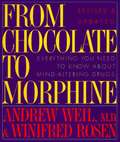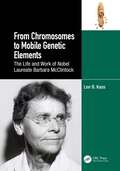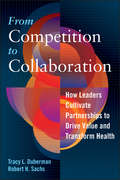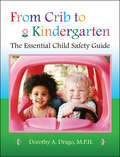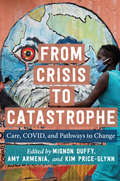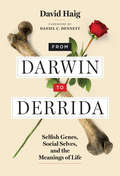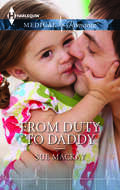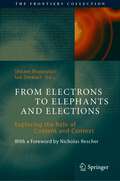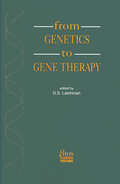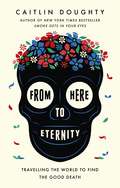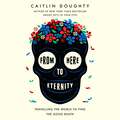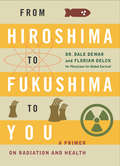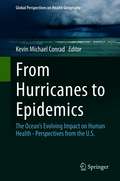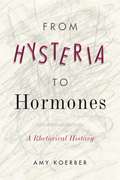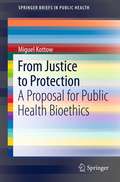- Table View
- List View
From Chocolate to Morphine: Everything You Need to Know About Mind-Altering Drugs (Revised and Updated)
by Andrew Weil Winifred RosenFrom coffee to marijuana to smart drugs, Dr. Weil's definitive guide to legal and illegal drugs - revised and updated for the 1990's. The authors insist that readers learn to distinguish drug use from drug abuse. As long as society continues to call all those who take disapproved substances "drug abusers," it will have an insoluble problem of enormous proportions. Real drug abusers are those in bad relationships with drugs,* whether the drugs are approved or disapproved by society, and unfortunately little can be done to help them, unless they want to change. Preventing drug abuse is a realistic goal. Two approaches are possible. One is to teach people, especially young people, how to satisfy their needs and desires without recourse to drugs. The second is to teach people how to form good relationships with drugs so that if they choose to use drugs, they will continue to be users and never become abusers.
From Christmas to Forever?
by Marion LennoxMelting his frozen heart Heiress Dr. Pollyanna Hargreaves has been wrapped in cotton wool all her life-now she's determined to strike out on her own! But she never expected to get stuck with handsome GP Dr. Hugo Denver for Christmas. He's meant to have left on holiday with his adorable niece already-not to be tempting her at every turn! As they're forced to work together Hugo's icy exterior soon begins to thaw. And it's not long before Polly realizes that she's falling for him...and for little Ruby, too!
From Chromosomes to Mobile Genetic Elements: The Life and Work of Nobel Laureate Barbara McClintock
by Lee B. KassThis biography of Nobel Laureate Barbara McClintock (1902-1992) places her life and work in its social, scientific and personal context. The author examines the development of Barbara McClintock’s scientific work and her influence upon individuals and upon the fields of cytogenetics and evolutionary biology in the period from 1902 to the present. The history documents years of McClintock’s notable and lauded scientific work long before she discovered and named transposable elements in the mid-1940s for which she ultimately received the Nobel Prize. The biography employs documented evidence to expose, demystify, and provide clarity for legends and misinterpretations of McClintock’s life and work.Key Features Exposes and demystifies myths and legends told about McClintock’s time in Missouri Clarifies the changing language of genes and genetics Places in perspective the history of McClintock’s research Documents McClintock’s family and early life before college Provides documented details of McClintock’s time in Nazi Germany
From Clone to Bone
by Robert J. Asher Johannes MüllerSince the 1980s, a renewed understanding of molecular development has afforded an unprecedented level of knowledge of the mechanisms by which phenotype in animals and plants has evolved. In this volume, top scientists in these fields provide perspectives on how molecular data in biology help to elucidate key questions in estimating paleontological divergence and in understanding the mechanisms behind phenotypic evolution. Paleobiological questions such as genome size, digit homologies, genetic control cascades behind phenotype, estimates of vertebrate divergence dates, and rates of morphological evolution are addressed, with a special emphasis on how molecular biology can inform paleontology, directly and indirectly, to better understand life's past. Highlighting a significant shift towards interdisciplinary collaboration, this is a valuable resource for students and researchers interested in the integration of organismal and molecular biology.
From Competition to Collaboration: How Leaders Cultivate Partnerships to Drive Value and Transform Health (ACHE Management)
by Tracy DubermanEvery healthcare executive knows that the US health system is in desperate need of repair, yet the path to real change remains unclear. The shift to value-based care is a step in the right direction, but the move to control costs while enhancing quality will require a significant transformation in all sectors of the field. No single enterprise can address these challenges on its own—organizations must work together, and across sectors, to optimize the value of their services and address affordability, access, and cost. From Competition to Collaboration: How Leaders Cultivate Partnerships to Drive Value and Transform Health explains how healthcare leaders can navigate the difficult issues that arise when multiple organizations from different sectors and with different operating models, objectives, and cultures work together toward a shared purpose. By using this book's health ecosystem leadership model (HELM), leaders can shift their mind-set toward a broader purpose, focusing not just on healthcare but on health and promoting wellness. Authors Tracy Duberman and Robert Sachs provide a roadmap for developing new leadership competencies. Using HELM, innovative leaders can work across the various segments of healthcare to meet the mission of creating healthier communities. To illustrate how this model is best applied, the authors offer a detailed fictional case study, as well as real-life examples from leaders who have demonstrated success with collaborative ecosystem initiatives. The book helps define the skills required for ecosystem leadership and presents concrete, actionable techniques and strategies for development. To make the essential shift toward healthier communities, healthcare needs leaders capable of building and maintaining relationships across the health ecosystem. From Competition to Collaboration offers the tools and guidance to help drive leaders toward this shared purpose.What Readers Are SayingKudos to Tracy Duberman and Bob Sachs for developing such an insightful and productive approach to help leaders succeed in their everyday efforts and defining moments by enhancing collaboration across the health industry. For any executive coach looking to support and inspire clients to reach up, out, and across, this is the essential playbook.”—Marshall Goldsmith, Multimillion-selling author or editor of 39 books, including Triggers and What Got You Here Won’t Get You There“If nothing else, my 25 years in healthcare as a frontline provider, physician leader, health plan executive, and health system executive have convinced me that meaningful transformation of the United States healthcare system is a team sport. The ecosystem is simply too vast and complex to allow for significant success in silos. This timely book is both informative and optimistic. It not only details the leadership traits required to drive meaningful change—more important, it lays out inspiring examples of where this is happening today, what can be learned, and, most critically, what can be cultivated.”—David G. Carmouche, MD, President, Ochsner Health Network, Senior Vice President of Community Care, Ochsner Health System
From Crib to Kindergarten: The Essential Child Safety Guide
by Dorothy A. DragoNamed One of the Best Consumer Health Books of 2007 by Library JournalIn childhood, the occasional bump or scrape comes with the territory. But serious injury is another matter, creating anxiety for even the most experienced parent. Fortunately, unintentional injury can be prevented. In this essential guide, an eminent child safety specialist explains how to reduce the risk of childhood injury at home—and beyond. Her tips help protect children from birth to age five—those who are most vulnerable to serious injury. She describes how to provide a safe environment during the daily activities of sleeping, eating, bathing, dressing, playing, and traveling. The major hazards and potential injuries associated with each activity are identified along with the age when the child is at greatest risk. Illustrations, checklists, and summary charts complement the text and put valuable lessons and critical information at parents’ fingertips.From Crib to Kindergarten is an indispensable "how to" for parents, grandparents, teachers, babysitters, and daycare providers.
From Crisis to Catastrophe: Care, COVID, and Pathways to Change
by Nancy Folbre Helen Dickinson Pat Armstrong Joan C. Tronto Laura Mauldin Zitha Mokomane Orly Benjamin Birgit Pfau-Effinger Juliana Martínez Franzoni Catherine Smith Ito Peng Sabrina Marchetti Martha MacDonald Cynthia J. Cranford Veena Siddharth Odichinma Akosionu Janette S. Dill J'Mag Karbeah Janna Klostermann María Nieves Rico Laura Pautassi Valeria Esquivel Pilar Gonalons-Pons Johanna S. Quinn Ameeta Jaga Ken Chih-Yan Sun Franziska Dorn Leila Gautham Merita Mesiäislehto Thurid Eggers Christopher Grages Cindy L. Cain Katherine Ravenswood Julie KashenThe COVID pandemic has shaken the material and social foundations of the world more than any event in recent history and has highlighted and exacerbated a longstanding crisis of care. While these challenges may be freshly visible to the public, they are not new. Over the last three decades, a growing body of care scholarship has documented the inadequacy of the social organization of care around the world, and the effect of the devaluation of care on workers, families, and communities. In this volume, a diverse group of care scholars bring their expertise to bear on this recent crisis. In doing so, they consider the ways in which the existing social organization of care in different countries around the globe amplified or mitigated the impact of COVID. They also explore the global pandemic's impact on the conditions of care and its role in exacerbating deeply rooted gender, race, migration, disability, and other forms of inequality.
From Darwin to Derrida: Selfish Genes, Social Selves, and the Meanings of Life (The\mit Press Ser.)
by David HaigHow the meaningless process of natural selection produces purposeful beings who find meaning in the world.In From Darwin to Derrida, evolutionary biologist David Haig explains how a physical world of matter in motion gave rise to a living world of purpose and meaning. Natural selection, a process without purpose, gives rise to purposeful beings who find meaning in the world. The key to this, Haig proposes, is the origin of mutable “texts”—genes—that preserve a record of what has worked in the world. These texts become the specifications for the intricate mechanisms of living beings.Haig draws on a wide range of sources—from Laurence Sterne's Tristram Shandy to Immanuel Kant's Critique of the Power of Judgment to the work of Jacques Derrida to the latest findings on gene transmission, duplication, and expression—to make his argument. Genes and their effects, he explains, are like eggs and chickens. Eggs exist for the sake of becoming chickens and chickens for the sake of laying eggs. A gene's effects have a causal role in determining which genes are copied. A gene (considered as a lineage of material copies) persists if its lineage has been consistently associated with survival and reproduction. Organisms can be understood as interpreters that link information from the environment to meaningful action in the environment. Meaning, Haig argues, is the output of a process of interpretation; there is a continuum from the very simplest forms of interpretation, instantiated in single RNA molecules near the origins of life, to the most sophisticated. Life is interpretation—the use of information in choice.
From Doctor to Daddy: A Surgeon For The Single Mum / From Doctor To Daddy (Mills And Boon Medical Ser.)
by Becky WicksCan he fix the past……by giving her daughter a future?Six years ago, Dr. Fraser Breckenridge allowed Sara to walk out of his life and has always regretted it. He seizes the opportunity to employ her on board a Caribbean cruise ship for dialysis patients, but Sara now has an adorable little girl who urgently needs a new kidney. Can Fraser uncover why Sara left and give her—and Esme—a reason to stay?“Both the main characters entertained me from start to finish due to the wonderful combination of intense moments because of their back stories as well as playful banter between the pair as they find a way to work together….”— Harlequin Junkie on Tempted by Her Hot-Shot Doc
From Duty to Daddy
by Sue MacKaySwapping the firing line...Army medic Marshall Hunter has never been able to get beautiful Charlie Lang out of his head, but despite their unforgettable fling his commitment to the forces leaves no time for relationships. Two years on he's unable to pass up one last opportunity to see Charlie again! Except the little girl playing in her garden proves that she's been able to move on even if he hasn't.......for fatherhood!Only, Charlie has a life-changing surprise in store for Marshall....
From Electrons to Elephants and Elections: Exploring the Role of Content and Context (The Frontiers Collection)
by Ian Stewart Shyam WuppuluriThis highly interdisciplinary book, covering more than six fields, from philosophy and sciences all the way up to the humanities and with contributions from eminent authors, addresses the interplay between content and context, reductionism and holism and their meeting point: the notion of emergence. Much of today’s science is reductionist (bottom-up); in other words, behaviour on one level is explained by reducing it to components on a lower level. Chemistry is reduced to atoms, ecosystems are explained in terms of DNA and proteins, etc. This approach fails quickly since we can’t cannot extrapolate to the properties of atoms solely from Schrödinger's equation, nor figure out protein folding from an amino acid sequence or obtain the phenotype of an organism from its genotype. An alternative approach to this is holism (top-down). Consider an ecosystem or an organism as a whole: seek patterns on the same scale. Model a galaxy not as 400 billion-point masses (stars) but as an object in its own right with its own properties (spiral, elliptic). Or a hurricane as a structured form of moist air and water vapour. Reductionism is largely about content, whereas holistic models are more attuned to context. Reductionism (content) and holism (context) are not opposing philosophies — in fact, they work best in tandem. Join us on a journey to understand the multifaceted dialectic concerning this duo and how they shape the foundations of sciences and humanities, our thoughts and, the very nature of reality itself.
From Enforcers to Guardians: A Public Health Primer on Ending Police Violence
by Mindy Thompson Fullilove Hannah L. CooperA public health approach to understanding and eliminating excessive police violence.Excessive police violence and its disproportionate targeting of minority communities has existed in the United States since police forces first formed in the colonial period. A personal tragedy for its victims, for the people who love them, and for their broader communities, excessive police violence is also a profound violation of human and civil rights.Most public discourse about excessive police violence focuses, understandably, on the horrors of civilian deaths. In From Enforcers to Guardians, Hannah L. F. Cooper and Mindy Thompson Fullilove approach the issue from a radically different angle: as a public health problem. By using a public health framing, this book challenges readers to recognize that the suffering created by excessive police violence extends far outside of death to include sexual, psychological, neglectful, and nonfatal physical violence as well.Arguing that excessive police violence has been deliberately used to marginalize working-class and minority communities, Cooper and Fullilove describe what we know about the history, distribution, and health impacts of police violence, from slave patrols in colonial times to war on drugs policing in the present-day United States. Finally, the book surveys efforts, including Barack Obama's 2015 creation of the Task Force on 21st Century Policing, to eliminate police violence, and proposes a multisystem, multilevel strategy to end marginality and police violence and to achieve guardian policing. Aimed at anyone seeking to understand the causes and distributions of excessive police violence—and to develop interventions to end it—From Enforcers to Guardians frames excessive police violence so that it can be understood, researched, and taught about through a public health lens.
From Fling to Forever
by Avril TremayneWhat started as a fling... When fate conspires repeatedly to throw together kindhearted nurse Ella Reynolds and deliciously sexy documentary filmmaker Aaron James, it's not long before this unlikely couple finally gives in to their irresistible chemistry. Their hearts might be locked away, but what does it matter when it's only a fling...? ...could lead to forever! Spending time and saving lives together is bound to break down barriers. Yet with so much heartbreak and loss to overcome, can their fling ever lead to forever?
From Fling to Wedding Ring: Tempted By The Brooding Surgeon / From Fling To Wedding Ring (Mills And Boon Medical Ser.)
by Karin BaineShe thinks she wants no strings…Can sexy surgeon Ben change her mind?Nurse Mollie Forrester has a reputation as an ice queen, and the scars from a childhood accident have convinced her no man could love her. When she’s paired with handsome surgeon Ben Sheridan in a dance competition, Mollie discovers he’s not the playboy everyone thinks he is. She finds passion in his arms—but can Ben persuade Mollie she’s worthy of love?
From Florida Fling to Forever
by Susan CarlisleRule number one? Forget their flingIf only it was that easy!Pioneering transplant surgeon Lily Evans is always cool under pressure. So why does the idea of working with ex-fling Max James have her so hot under the collar? Max is just passing through Florida, after all, and maintaining a professional relationship is top of their agenda. Yet Lily&’s sensible head is being overruled by her unusually reckless heart as she begins to fall for more than just Max&’s roguish charms… &“Author Susan Carlisle has once again gifted us with a beautiful tale. Readers would be hooked to the pages till the end and root for these two characters to get to their happy ever after. Highly recommended for all readers of romance.&”-Goodreads on Taming the Hot-Shot Doc &“Ms. Carlisle wrote a wonderful, flirty, and enjoyable romance that should not be missed. She provided a tale rich with emotions, sizzling chemistry, vivid scenic descriptions, and realistic characters…. I highly recommend Reunited with her Daredevil Doc to other readers.&”-Goodreads
From Genetics to Gene Therapy: The Molecular Pathology of Human Disease
by David S. LatchmanDistinguished scientists provide an overview of the molecular pathology of human disease. Each chapter provides an analysis of the molecular biological approaches to individual diseases, such as leukaemia, cardiovascular disease and cancer. To celebrate the formation of the new Department a I-day meeting entitled 'From Genetics to Gene Therapy' was held on 14 December 1992, at which a large audience was inspired by talks from a variety of distinguished speakers. This volume is based on the meeting and contains contributions provided by the invited speakers.
From Hawaii to Forever
by Julie DanversTwo things she never meant to fall for:Hawaii…and him!When her perfect life implodes, high-flying city doctor Kat Murphy plans the ultimate escape. In Hawaii, she finds sun, sea and sand on her doorstep—and delicious paramedic Jack Harper to rescue her from drowning! Her fascinatingly carefree new colleague is temptation personified… And when Kat can no longer resist, she has an enticing offer for the island’s most eligible bachelor: a fling without forever…
From Heartache to Forever: From Heartache To Forever (yoxburgh Park Hospital) / Melting The Trauma Doc's Heart (Yoxburgh Park Hospital #1000)
by Caroline AndersonPassion, pregnancy, heartbreak…Can they find their happy-ever-after?Fresh out of broken relationships, trauma specialist Ryan McKenna and nurse Beth Costello’s passion-fueled fling was a welcome escape. But the shock of an unexpected pregnancy and the heartache of losing the baby they never knew they wanted was too much to bear. Now, working together again in Yoxburgh, where they first made love, can they finally get to know each other…and discover they’re meant to be together?“This book develops into a sensitive and very well-done love story. This delightful book worked on all levels and was quite an emotional read. Having not read anything by Caroline Anderson before, this was a wonderful way to be introduced to her excellent writing.”— Goodreads on A Single Dad to Heal Her Heart“Overall, Ms. Anderson has delivered a really good read in this book where emotions run high; the chemistry between this couple was tangible; the romance was wonderful….”— Harlequin Junkie on One Night, One Unexpected Miracle
From Here to Eternity: Travelling the World to Find the Good Death
by Caitlin DoughtyAs a practising mortician, Caitlin Doughty has long been fascinated by our pervasive terror of dead bodies. In From Here to Eternity she sets out in search of cultures unburdened by such fears. With curiosity and morbid humour, Doughty introduces us to inspiring death-care innovators, participates in powerful death practices almost entirely unknown in the West and explores new spaces for mourning - including a futuristic glowing-Buddha columbarium in Japan, a candlelit Mexican cemetery, and America's only open-air pyre. In doing so she expands our sense of what it means to treat the dead with 'dignity' and reveals unexpected possibilities for our own death rituals.
From Here to Eternity: Travelling the World to Find the Good Death
by Caitlin DoughtyAs a practising mortician, Caitlin Doughty has long been fascinated by our pervasive terror of dead bodies. In From Here to Eternity she sets out in search of cultures unburdened by such fears. In rural Indonesia, she observes a man clean and dress his grandfather's mummified body. She meets Bolivian ñatitas (cigarette-smoking, wish-granting human skulls), and introduces us to the Japanese ritual of kotsuage, in which relatives use chopsticks to pluck their loved-ones' bones from cremation ashes. With curiosity and morbid humour, Doughty introduces us to inspiring death-care innovators, participates in powerful death practices almost entirely unknown in the West and explores new spaces for mourning - including a futuristic glowing-Buddha columbarium in Japan, a candlelit Mexican cemetery, and America's only open-air pyre. In doing so she expands our sense of what it means to treat the dead with 'dignity' and reveals unexpected possibilities for our own death rituals.Read by Caitlin Doughty(p) 2017 Recorded Books LLC
From Hiroshima to Fukushima to You: A Primer on Radiation and Health
by Florian Oelck Dale DewarThe bombing of Hiroshima on August 6, 1945, brought radiation to international attention but the exact nature of what had been unleashed was still unclear to most. The 1986 meltdown at the Chernobyl nuclear plant again made headlines with estimates of fatalities ranging from 4000 to almost a million deaths. By the time of the shocking 2011 disaster at the Fukushima nuclear plant social media meant governments and corporations no longer had a monopoly over the release of information, but transparency remains low on the agenda. Meanwhile, few physicians give thought to the delayed health effects of radiation. It has been the bold physician who has challenged the potential overuse of chest X-rays, CT scanning, or PET scans. This book provides clear and accurate information about radiation so that we can all make informed choices. In clear language it offers answers to citizens’ questions: What is radiation? Where do we encounter it? What are the benefits and risks? How do we develop a responsible future around the uses and abuses of radioactivity?
From Hurricanes to Epidemics: The Ocean's Evolving Impact on Human Health - Perspectives from the U.S. (Global Perspectives on Health Geography)
by Kevin ConradThis book provides a complete and current overview of the correlation between ocean conditions and human health, publishing comprehensively for the first time on the direct interactions among oceanography, marine biology and impacts on human health. Specifically the text addresses how changing ocean conditions result in health impacts and disruptions, with a focus on cases in the USA. The changing ocean conditions that are discussed include diminishing marine biodiversity, climactic changes such as intensified weather events, shifting sea currents and increasing sea temperature. The book addresses the resulting health issues brought about by these various ocean conditions, such as emerging infectious diseases, starvation and poisoning among impacted communities, toxic algae blooms, threatened ecosystems, and other future implications. The text was developed in conjunction with scientists from Brown University, the University of Rhode Island, the University of Texas at Austin, the University of California at Riverside and Ochsner Health, all located in areas deeply impacted by the changing Oceans. The book will be of interest to marine research scientists, health care professionals, students, and general enthusiasts of oceanography and health.
From Hysteria to Hormones: A Rhetorical History (RSA Series in Transdisciplinary Rhetoric #7)
by Amy KoerberIn From Hysteria to Hormones, Amy Koerber examines the rhetorical activity that preceded the early twentieth-century emergence of the word hormone and the impact of this word on expert understandings of women’s health.Shortly after Ernest Henry Starling coined the term “hormone” in 1905, hormones began to provide a chemical explanation for bodily phenomena that were previously understood in terms of “wandering wombs,” humors, energies, and balance. In this study, Koerber posits that the discovery of hormones was not so much a revolution as an exigency that required old ways of thinking to be twisted, reshaped, and transformed to fit more scientific turn-of-the-century expectations of medical practices. She engages with texts from a wide array of medical and social scientific subdisciplines; with material from medical archives, including patient charts, handwritten notes, and photographs from the Salpêtrière Hospital, where Dr. Jean Charcot treated hundreds of hysteria patients in the late nineteenth century; and with current rhetorical theoretical approaches to the study of health and medicine. In doing so, Koerber shows that the boundary between older, nonscientific ways of understanding women’s bodies and newer, scientific understandings is much murkier than we might expect.A clarifying examination of how the term “hormones” preserves key concepts that have framed our understanding of women’s bodies from ancient times to the present, this innovative book illuminates the ways in which the words we use today to discuss female reproductive health aren’t nearly as scientifically accurate or socially progressive as believed. Scholars of rhetoric, gender studies, and women’s health will find Koerber’s work provocative and valuable.
From Immigration Controls to Welfare Controls (The\state Of Welfare Ser.)
by Steve Cohen Beth Humphries Ed MynottThis edited collection addresses theoretical, political and practical aspects of the connection between external immigration controls and internal welfare controls. It considers the implications for the both those subject to controls and those drawn into the web of implementing internal welfare controls. Topics discussed include:* forced dispersal of asylum seekers* local authority and voluntary sector regulations* nationalism, racism, class and 'fairness'* strategies for resistance to controls* USA controls.The book provides support to those unwittingly drawn into administering controls, showing how the role of welfare workers as immigration control enforcers is not a sudden imposition but has exisited since the introduction of controls in 1905.From Immigration Controls to Welfare Controls will provide a valuable resource for all those professionals who come into contact with the issues surrounding immigration.
From Justice to Protection
by Miguel KottowIn most developed countries, the epidemiological disease profile has changed from infectious to degenerative, causing major alterations in epidemiological thinking and public health policies. Less developed nations have to deal with a more complex situation, because social disparities create highly unequal health conditions, the affluent being afflicted by degenerative conditions, whereas the poorer social segments continue to suffer infectious diseases, but also begin to feel the effects of chronic illness. At the turn of the 21st century, equity in health care is not being served, and social justice has lost credibility as a conceptual driving force of public health policies. Rampant injustice confirms that theories, reality and suggested practices of just social orders are flawed, leaving the needy without help or hope in a world of flagrant ethical inadequacy. And yet, mainstream bioethics loses meaning and relevance as it clings to the principle of justice and hails such concepts as global justice and universal health-care equity, misleadingly focusing on justice as a desideratum. This book pleads for an urgent turn towards directly addressing injustice as a reality that requires pressingly needed arguments and proposals to inspire realistic public health policies and programs based on an ethics of protection. Ever since Hobbes, all shades of political philosophy accept that the basic obligation of the ruling power is to protect its subjects. The ethics of protection emphasizes aiding the needy and the disempowered in obtaining access to basic goods and services related to health-care. Public health is called upon to fulfill protective obligations to guarantee disease prevention and medical services to the population, taking special care to safeguard those unable to cover their health-care needs in market-oriented medical services and institutions. The bioethics of protection developed in this text presents specific and explicit guide-lines to assure that protective public health actions be efficacious (problem-solving), efficient (sustainable cost/benefit relation) and ethically sound (respecting human rights and the common weal). These guide-lines are designed to give ethical support and justification to public health policies even when they require some unavoidable limitations of individual autonomy to promote social health benefits.
